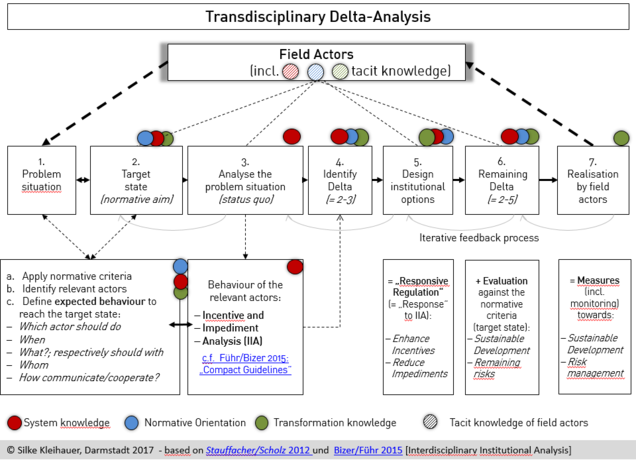Transdisciplinary Delta Analysis
The Transdisciplinary Delta Analysis as a behaviour-orientated research approach
Transformative research makes a contribution to achieve the Sustainable Development Goals (SDG’s) of the United Nations. [1]
Research that is organized accordingly is not only depending on the cooperation of the actors, but also on their expertise and creativity. As a result of this is the methodical approach of the transdisciplinary Delta analysis divided in seven steps (see figure):

- The starting point is a specific problem situation with regard to a challenge in terms of Risk and/or Sustainability aspects. The actors play a central role in the characterization of the problem situation, since they have a – partly implicit – knowledge of the circumstances which lead to the problem (tacit knowledge; see „Knowledge types“).
This applies in particular if a problem is originated from corporate practice. - The project team specifies (together with the actors) the problem (target aim in consideration of normative criteria’s): It formulated what is aimed under the perspective of appropriate control of the risks and sustainable development. The team makes a connection between normative orientation and system knowledge, to establish the normative aim and its required research scope. Relevant actors and how they can be involved in the current phase but also in later research steps (Transformation knowledge) are identified. With regard to the normative aim it is important to describe which contributions of the different actors have to be provided when and in which way.
- Based on this, the risks and unsustainable factors (in and for the organisation) are analysed. This step generates system knowledge. It is relevant to recognize the factors which lead to higher risks and unsustainable development. Factors like this can have their roots in organisational structures, products and services, the product developments process, stakeholder behaviour or in the behaviour of internal actors. The incentives and impediments for the actors in the status quo are analysed. Sofia applies a stage heuristic of the interdisciplinary institutional analysis (for teaching summarized in „Kompaktleitfaden", Bizer & Führ 2014) to analyse the behaviour of actors (Incentive and Impediments Analysis). Aim of the analysis is to show the connections and relevant factors of the („status-quo“).
- The comparison of normative aim and status quo results normally in a „Delta“: The „problem situation“(step 1) shows that the incentive and impediments situation in the status-quo does not impact the behaviour of the actors in the way that they bring in the required contribution of the normative aim.
- The next step identifies configuration options to minimize the „Delta“. This step contains development options and describes the processes of change. It is based on behaviour forecast and on scenarios which describes how the Delta should be approached and which expenses are connected (Development of configuration options). At this step the Transformation knowledge is paramount, based on the system knowledge of step 3, but also the knowledge of the aims (normative orientation).
- The configuration options are measured by the criteria’s and aims which were formulated in the beginning. Normally it’s predictable that it’s not possible to achieve all elements of the aim description by the developed configuration options. To face the „Rest-Delta“ is an important interim step that connects all knowledge types, especially the system knowledge. Risk Management measures, normally including monitoring instruments, can be developed on that basis..
- Finally, suitable strategies are developed to realize the analysed options for action. The realization of the options for action is part of the actor’s spheres. Transformation knowledge is necessary to work on realization strategies.
The different analysis steps can‘t be implemented in separation from the research aim. For a pragmatic, action orientated approach it is necessary to include the next steps result-orientated. Further, every configuration option is just a preliminary solution, its practical suitability and impact has to be watched and evaluated separately, to start an adjustment whereby the process begins again with step 1.
[1] UN General Assembly, Transforming our world: the 2030 Agenda for Sustainable Development, Resolution adopted by the General Assembly, 25.9.2015, A/70/L.1.

